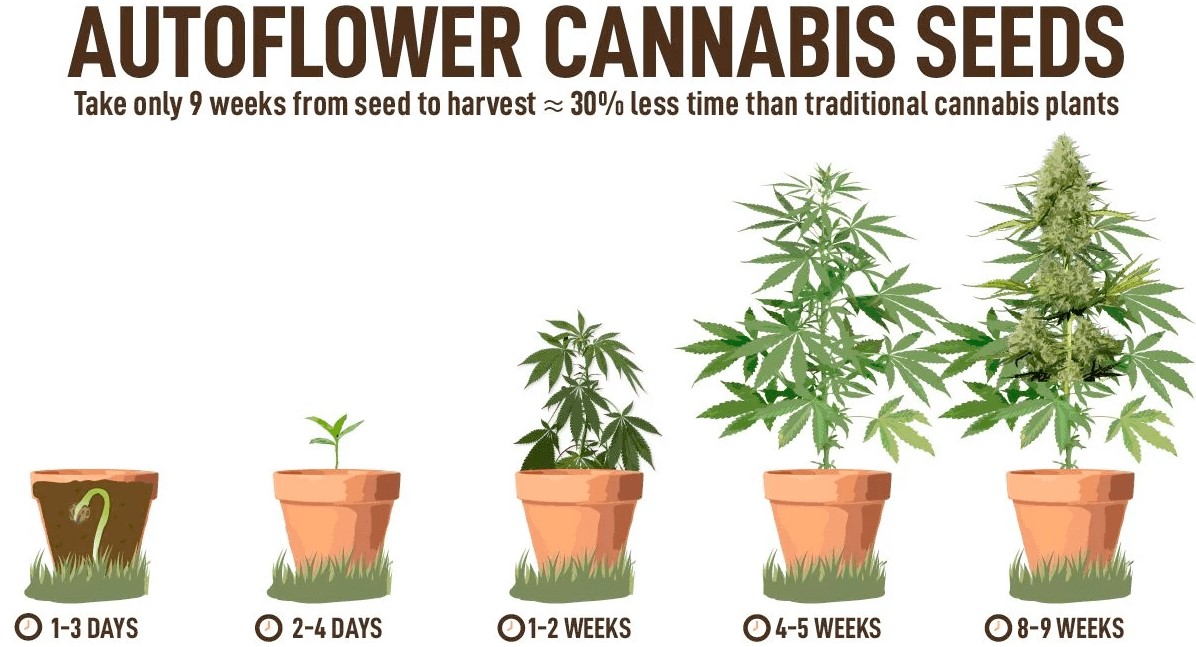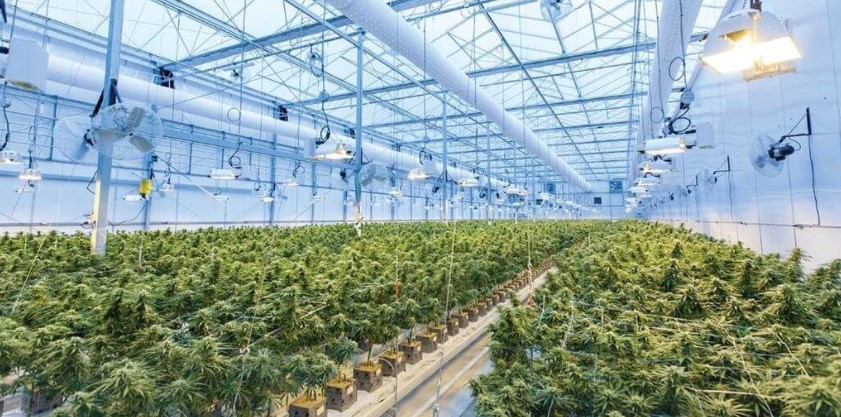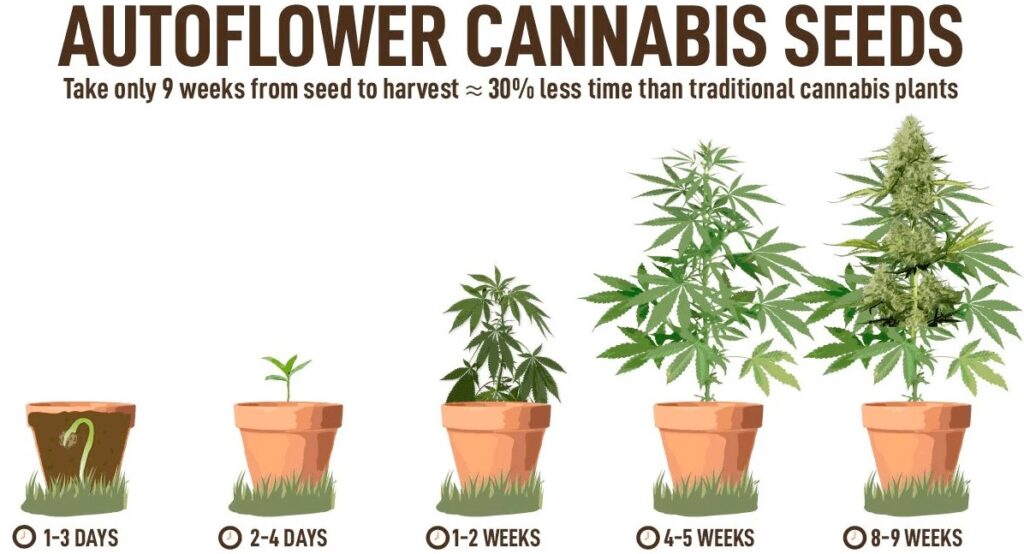- Brief overview of the current cannabis industry and the rise of autoflowering cannabis strains
- Purpose of the post: to explore the potential of autoflowering cannabis seeds for commercial cultivation
II. What are Autoflowering Cannabis Seeds?
- Definition and characteristics of autoflowering cannabis strains
- The history and development of autoflowering cannabis seeds
- The benefits of growing autoflowering cannabis strains
III. Advantages of Autoflowering Cannabis Seeds for Commercial Cultivation
- Shorter grow times and faster harvests
- Greater flexibility in grow cycles
- Space-saving benefits and potential for higher yields
- Potential for cost savings in cultivation
IV. Challenges of Autoflowering Cannabis Seeds for Commercial Cultivation
- Limitations in plant size and yield potential
- Lack of stability in genetics
- Limited options in strain selection
- Potential for inconsistent growth patterns
V. Best Practices for Cultivating Autoflowering Cannabis Seeds Commercially
- Tips for maximizing yields and minimizing risks
- Best practices for optimizing grow conditions and environment
- Strategies for managing genetic variability and stability
VI. The Future of Autoflowering Cannabis Seeds in Commercial Cultivation
- Emerging trends and innovations in autoflowering cannabis strains
- Potential impact on the cannabis industry and market
- Future research and development opportunities
- Recap of the potential of autoflowering cannabis seeds for commercial cultivation
- Call-to-action for readers to consider incorporating autoflowering cannabis strains into their cultivation practices
- Final thoughts and recommendations.
I. Introduction
The cannabis industry has experienced significant growth and evolution over the last decade, driven in part by advances in cultivation techniques and genetic development. One of the most recent developments in cannabis cultivation has been the rise of autoflowering cannabis strains. Unlike traditional cannabis strains, which require specific light cycles to trigger the flowering phase, autoflowering strains automatically flower based on age, making them faster and easier to grow.
As the cannabis industry continues to mature and expand, many cultivators are looking to incorporate autoflowering strains into their cultivation practices. In this post, we’ll explore the potential of autoflowering cannabis seeds for commercial cultivation, including their advantages and challenges, best practices for cultivation, and the future of autoflowering cannabis strains in the industry. Whether you’re a seasoned cultivator or just starting out, understanding the potential of autoflowering cannabis seeds could be key to achieving success in this rapidly growing industry.
II. What are Autoflowering Cannabis Seeds?
Autoflowering cannabis seeds are a relatively new development in the world of cannabis cultivation. These strains are unique because they automatically transition from the vegetative phase to the flowering phase based on age, rather than being triggered by specific light cycles like traditional cannabis strains.
- Definition and Characteristics of Autoflowering Cannabis Strains: Autoflowering strains are characterized by their short stature, rapid growth cycle, and automatic flowering process. These strains typically reach maturity in as little as 8-10 weeks from seed, compared to traditional strains which can take upwards of 16 weeks or more. Additionally, autoflowering strains are typically smaller in size, making them ideal for growers with limited space or those looking to maximize yields in small areas.
- The History and Development of Autoflowering Cannabis Seeds: The development of autoflowering cannabis seeds can be traced back to the 1920s, when Russian botanist L.S. Vavilov first discovered a wild strain of cannabis in Siberia that flowered automatically. However, it wasn’t until the 1980s that Dutch Passion, a Dutch seed bank, began experimenting with these strains to create stable autoflowering seeds. Since then, other seed banks have followed suit, creating a wide variety of autoflowering strains that cater to different growing environments and preferences.
- The Benefits of Growing Autoflowering Cannabis Strains: There are several benefits to growing autoflowering cannabis strains, including:
- Shorter grow times and faster harvests: Because autoflowering strains have shorter vegetative phases and automatically flower, growers can harvest their crops in as little as 8-10 weeks from seed, compared to traditional strains which can take months.
- Greater flexibility in grow cycles: Because autoflowering strains are not dependent on light cycles, growers can cultivate these strains year-round, indoors or outdoors, without having to manipulate lighting schedules.
- Space-saving benefits and potential for higher yields: Autoflowering strains are typically smaller in size than traditional strains, but they can still produce impressive yields due to their faster growth cycle and ability to be grown in high-density arrangements.
- Potential for cost savings in cultivation: Because autoflowering strains have shorter grow times and don’t require as much manipulation of lighting schedules, they can potentially reduce costs associated with electricity, labor, and other inputs.
In summary, autoflowering cannabis strains offer several benefits to growers, including faster grow times, greater flexibility in cultivation, space-saving benefits, and potential cost savings. These strains are an exciting development in the cannabis industry and have the potential to significantly impact the future of commercial cultivation.
III. Advantages of Autoflowering Cannabis Seeds for Commercial Cultivation
As the cannabis industry continues to grow and mature, more and more cultivators are turning to autoflowering cannabis seeds for their commercial cultivation practices. Here are some of the key advantages of using autoflowering seeds for commercial cultivation:
- Shorter Grow Times and Faster Harvests.
One of the biggest advantages of using autoflowering cannabis seeds for commercial cultivation is the shorter grow times and faster harvests. Traditional cannabis strains can take several months to mature, but autoflowering strains can be harvested in as little as 8-10 weeks from seed. This means that cultivators can produce more harvests per year, increasing their overall yield and revenue potential. - Greater Flexibility in Grow Cycles.
Autoflowering strains offer greater flexibility in grow cycles than traditional cannabis strains. Because autoflowering strains don’t depend on light cycles to trigger the flowering phase, they can be grown year-round, indoors or outdoors. This means that cultivators can produce crops more frequently and adjust their production schedules based on market demand or other factors. - Space-Saving Benefits and Potential for Higher Yields.
Autoflowering strains are typically smaller in size than traditional strains, which means that growers can cultivate them in high-density arrangements to maximize space and yields. Additionally, because autoflowering strains have shorter grow times, growers can produce more crops per year, further increasing their overall yield potential. - Potential for Cost Savings in Cultivation.
Because autoflowering strains have shorter grow times and require less manipulation of light cycles, they can potentially reduce costs associated with electricity, labor, and other inputs. Additionally, because autoflowering strains can be grown in smaller spaces, cultivators may be able to reduce costs associated with facility size and maintenance.
In summary, the advantages of using autoflowering cannabis seeds for commercial cultivation include shorter grow times and faster harvests, greater flexibility in grow cycles, space-saving benefits, and potential cost savings. These advantages make autoflowering strains an attractive option for cultivators looking to maximize their yield potential and increase their overall profitability.
IV. Challenges of Autoflowering Cannabis Seeds for Commercial Cultivation
While autoflowering cannabis seeds offer many advantages for commercial cultivation, they also present certain challenges that growers need to be aware of. Here are some of the main challenges associated with growing autoflowering strains for commercial purposes:
1.Limitations in Plant Size and Yield
Potential One of the main challenges of growing autoflowering cannabis seeds for commercial cultivation is the limitation in plant size and yield potential. Autoflowering strains tend to be smaller than traditional strains, which means that they produce less biomass and have lower overall yield potential. While some cultivators have been able to achieve impressive yields with autoflowering strains, others may find that the limitations in size and yield make it difficult to meet their production goals.
2. Lack of Stability in Genetics
Another challenge of growing autoflowering cannabis seeds for commercial cultivation is the lack of stability in genetics. Because autoflowering strains are relatively new and have undergone less breeding and stabilization than traditional strains, they can be less predictable in terms of their growth patterns and overall quality. This can make it difficult for growers to produce consistent crops that meet their quality standards.
3. Limited Options in Strain Selection
While the number of available autoflowering strains is growing, there are still fewer options for cultivators than there are for traditional strains. This limited selection can make it difficult for growers to find the right strains for their specific cultivation needs and market demands.
4. Potential for Inconsistent Growth Patterns
Finally, because autoflowering strains are less predictable than traditional strains, they may be more prone to inconsistent growth patterns. This can lead to issues with crop quality and yield, and can make it difficult for growers to plan their production schedules and meet market demand.
In summary, the challenges of growing autoflowering cannabis seeds for commercial cultivation include limitations in plant size and yield potential, lack of stability in genetics, limited options in strain selection, and potential for inconsistent growth patterns. While these challenges may be significant, they can be overcome with careful cultivation practices and a focus on quality and consistency.
V. Best Practices for Cultivating Autoflowering Cannabis Seeds Commercially
- Maximize yields by optimizing grow conditions and environment
- Light: Autoflowering cannabis plants require intense light, ideally around 18 hours of light per day, for maximum yield. Use high-quality LED or HPS grow lights to provide sufficient light intensity and spectrum.
- Temperature and humidity: Keep the grow room temperature between 70-85°F (21-29°C) and maintain a humidity level of around 50-60%. Avoid high humidity as it can promote mold and mildew growth, which can ruin the crop.
- Air circulation: Good air circulation is essential to prevent stagnant air, which can lead to pests and diseases. Use fans and/or an air conditioning system to maintain proper ventilation.
- Nutrients: Use a high-quality nutrient solution that contains a balanced ratio of nitrogen (N), phosphorus (P), and potassium (K), as well as secondary and micronutrients. Follow the manufacturer’s instructions on the dosage and application.
- pH and EC levels: Keep the pH level between 6.0-6.5 and the EC level between 1.0-2.5. Test the pH and EC levels regularly and adjust if necessary to maintain optimal nutrient uptake and growth.
- Watering: Avoid over-watering or under-watering the plants. Water the plants when the soil is dry to the touch, and allow the excess water to drain out of the pot.
- Minimize risks by managing genetic variability and stability
- Source reliable genetics: Choose autoflowering cannabis seeds from reputable breeders or seed banks that have a proven track record of stable genetics and high-quality seeds.
- Maintain genetic stability: Keep the mother plant healthy and disease-free, and avoid cross-pollination with other cannabis plants to maintain genetic stability. Use a designated mother plant for consistent genetics.
- Monitor for pests and diseases: Regularly inspect the plants for signs of pests and diseases, such as spider mites, whiteflies, or powdery mildew. If detected, take immediate action to prevent the spread and treat the affected plants with appropriate solutions.
- Quarantine new plants: Before introducing new plants to the grow room, quarantine them for at least two weeks to monitor for pests and diseases.
- Practice proper sanitation: Keep the grow room and equipment clean and disinfected to prevent the spread of pests and diseases.
- Optimize growing techniques for maximum yield
- Training techniques: Use training techniques such as low-stress training (LST), high-stress training (HST), and pruning to control plant growth and promote bud development.
- Timing: Autoflowering cannabis plants have a fixed growth cycle, so timing is critical. Start the plants in a small pot and transplant them into a larger pot once they have developed a few sets of leaves. Harvest the plants when the buds are ripe and ready.
- Use quality soil: Use high-quality soil that is rich in organic matter and nutrients. Avoid soil that contains pesticides or herbicides, as they can harm the plants and reduce the yield.
- Provide CO2 enrichment: Provide additional CO2 to the grow room to increase plant growth and yield. A CO2 generator or bottled CO2 can be used for this purpose.
- Use hydroponic systems: Hydroponic systems can provide a controlled environment and maximize nutrient uptake, leading to higher yields.
By implementing these best practices for cultivating autoflowering cannabis seeds commercially, growers can maximize yields, minimize risks, and optimize growing techniques for high-quality, consistent results.
VI. The Future of Autoflowering Cannabis Seeds in Commercial Cultivation
As the cannabis industry continues to grow and evolve, the future of autoflowering cannabis seeds in commercial cultivation looks promising. Here are some emerging trends and innovations to watch out for:
- New autoflowering strains: Breeders are constantly developing new autoflowering strains with unique flavors, aromas, and effects. These new strains are often more potent and offer a wider range of medicinal benefits, making them attractive to both medical and recreational consumers.
- Improved genetics: As research continues, breeders are working to improve the genetics of autoflowering strains, making them more stable, predictable, and resistant to pests and diseases. This could result in higher yields and better quality crops.
- Technological innovations: Advances in technology are making it easier for growers to cultivate autoflowering cannabis seeds commercially. For example, new lighting systems, hydroponic setups, and automated nutrient delivery systems can help optimize growing conditions and improve yields.
- Increased demand: As more states legalize cannabis for medical and recreational use, the demand for high-quality, consistent cannabis products is expected to increase. Autoflowering cannabis seeds could be a cost-effective way for growers to meet this demand while also reducing the risk of crop failure.
The potential impact of these trends and innovations on the cannabis industry and market is significant. With the development of new and improved autoflowering strains, growers may be able to produce higher yields of potent, consistent cannabis products, which could lead to increased profits and a more stable industry.
Moreover, the availability of cost-effective, high-quality autoflowering cannabis seeds could make it easier for small-scale growers to enter the market, resulting in greater diversity and competition in the industry.
Future research and development opportunities in autoflowering cannabis seeds include:
- Genetics and breeding: Further research into the genetics of autoflowering cannabis strains could help breeders develop more stable, predictable strains with higher yields and better quality crops.
- Nutrient management: More research is needed on the optimal nutrient management practices for autoflowering cannabis plants, especially as new strains with different nutrient requirements are developed.
- Pest and disease management: Continued research into effective pest and disease management strategies for autoflowering cannabis plants could help reduce the risk of crop failure and improve yields.
In conclusion, the future of autoflowering cannabis seeds in commercial cultivation is bright, with new strains, improved genetics, and technological innovations promising to make it easier for growers to produce high-quality, consistent crops. As the industry continues to evolve, there are many exciting opportunities for research and development in this area.
VII. Conclusion
In conclusion, autoflowering cannabis seeds offer great potential for commercial cultivation. They are easy to grow, have a shorter flowering period, and are generally more resistant to pests and diseases compared to traditional photoperiod strains. This makes them an attractive option for growers looking to maximize yields and minimize risks.
Furthermore, with emerging trends and innovations in autoflowering cannabis strains, the future of this type of cultivation looks bright. New strains with unique flavors, aromas, and effects, as well as improved genetics and technological innovations, could lead to higher yields and better quality crops.
Therefore, we encourage readers to consider incorporating autoflowering cannabis strains into their cultivation practices. Whether you are a small-scale or large-scale grower, incorporating these seeds into your crop rotation could provide a number of benefits, such as increased yields, reduced risk of crop failure, and greater flexibility in your growing schedule.
However, it’s important to note that there are still many factors to consider when growing autoflowering cannabis seeds, such as nutrient management, pest and disease control, and environmental conditions. We recommend that growers conduct thorough research and seek guidance from experts in the field to optimize their cultivation practices.
In summary, autoflowering cannabis seeds offer a promising future for commercial cultivation, and we encourage growers to explore this option and stay up-to-date with the latest trends and innovations in this area.







